Houjun Sun
Sparse Multi-baseline SAR Cross-modal 3D Reconstruction of Vehicle Targets
Jun 06, 2024



Abstract:Multi-baseline SAR 3D imaging faces significant challenges due to data sparsity. In recent years, deep learning techniques have achieved notable success in enhancing the quality of sparse SAR 3D imaging. However, previous work typically rely on full-aperture high-resolution radar images to supervise the training of deep neural networks (DNNs), utilizing only single-modal information from radar data. Consequently, imaging performance is limited, and acquiring full-aperture data for multi-baseline SAR is costly and sometimes impractical in real-world applications. In this paper, we propose a Cross-Modal Reconstruction Network (CMR-Net), which integrates differentiable render and cross-modal supervision with optical images to reconstruct highly sparse multi-baseline SAR 3D images of vehicle targets into visually structured and high-resolution images. We meticulously designed the network architecture and training strategies to enhance network generalization capability. Remarkably, CMR-Net, trained solely on simulated data, demonstrates high-resolution reconstruction capabilities on both publicly available simulation datasets and real measured datasets, outperforming traditional sparse reconstruction algorithms based on compressed sensing and other learning-based methods. Additionally, using optical images as supervision provides a cost-effective way to build training datasets, reducing the difficulty of method dissemination. Our work showcases the broad prospects of deep learning in multi-baseline SAR 3D imaging and offers a novel path for researching radar imaging based on cross-modal learning theory.
Towards Large-scale Single-shot Millimeter-wave Imaging for Low-cost Security Inspection
May 25, 2023Abstract:Millimeter-wave (MMW) imaging is emerging as a promising technique for safe security inspection. It achieves a delicate balance between imaging resolution, penetrability and human safety, resulting in higher resolution compared to low-frequency microwave, stronger penetrability compared to visible light, and stronger safety compared to X ray. Despite of recent advance in the last decades, the high cost of requisite large-scale antenna array hinders widespread adoption of MMW imaging in practice. To tackle this challenge, we report a large-scale single-shot MMW imaging framework using sparse antenna array, achieving low-cost but high-fidelity security inspection under an interpretable learning scheme. We first collected extensive full-sampled MMW echoes to study the statistical ranking of each element in the large-scale array. These elements are then sampled based on the ranking, building the experimentally optimal sparse sampling strategy that reduces the cost of antenna array by up to one order of magnitude. Additionally, we derived an untrained interpretable learning scheme, which realizes robust and accurate image reconstruction from sparsely sampled echoes. Last, we developed a neural network for automatic object detection, and experimentally demonstrated successful detection of concealed centimeter-sized targets using 10% sparse array, whereas all the other contemporary approaches failed at the same sample sampling ratio. The performance of the reported technique presents higher than 50% superiority over the existing MMW imaging schemes on various metrics including precision, recall, and mAP50. With such strong detection ability and order-of-magnitude cost reduction, we anticipate that this technique provides a practical way for large-scale single-shot MMW imaging, and could advocate its further practical applications.
Compressive Sensing Based Sparse MIMO Array Optimization for Wideband Near-Field Imaging
Aug 09, 2022



Abstract:In the area of near-field millimeter-wave imaging, the generalized sparse array synthesis (SAS) method is in great demand. The traditional methods usually employ the greedy algorithms, which may have the convergence problem. This paper proposes a convex optimization model for the multiple-input multiple-output (MIMO) array design based on the compressive sensing (CS) approach. We generate a block shaped reference pattern, to be used as an optimizing target. The pattern occupies the entire imaging area of interest in order to involve the effect of each pixel into the optimization model. In MIMO scenarios, we can fix the transmit subarray and synthesize the receive subarray, and vice versa, or doing the synthesis sequentially. The problems associated with focusing, sidelobes suppression, and grating lobes suppression of the synthesized array are examined in details. Numerical and experimental results demonstrate that the synthesized sparse array can offer better image qualities than the sparse arrays with equally spaced or randomly spaced antennas with the same number of antenna elements.
Near-Field Millimeter-Wave Imaging via Arrays in the Shape of Polyline
Sep 07, 2021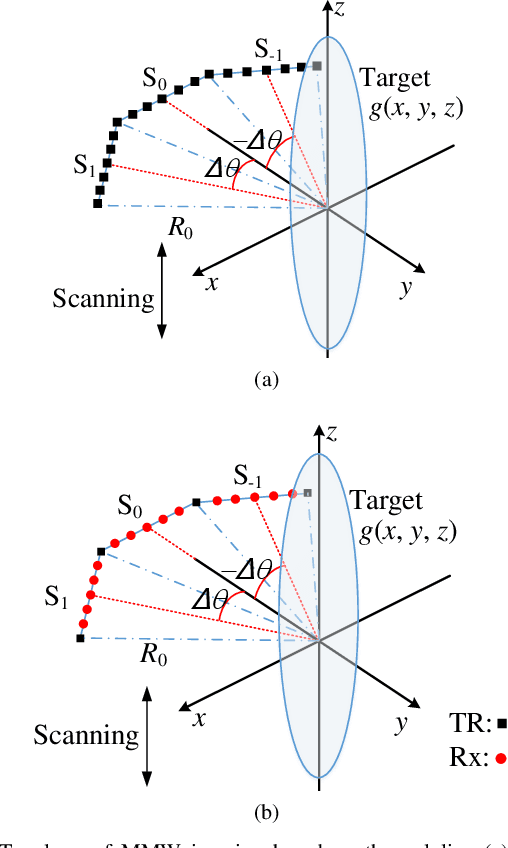
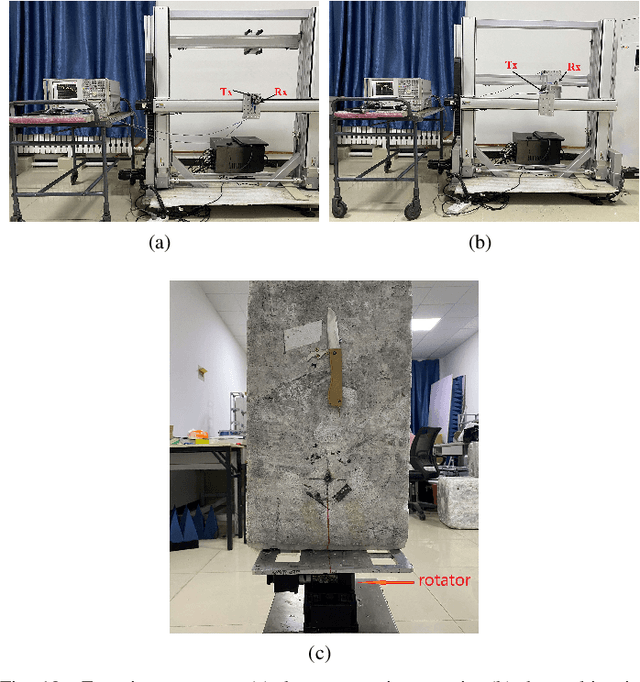
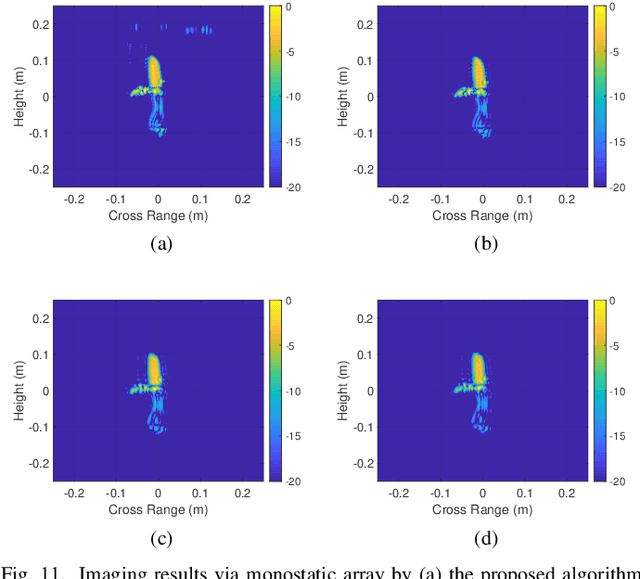
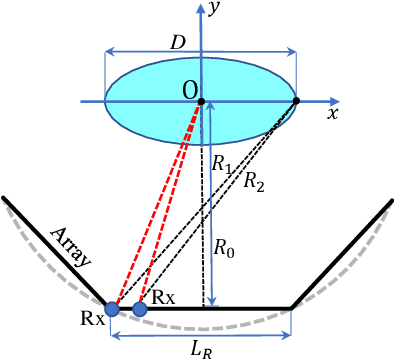
Abstract:This paper proposes a polyline shaped array based system scheme, associated with mechanical scanning along the perpendicular direction of the array, for near-field millimeter-wave (MMW) imaging. Each section of the polyline is a chord of a circle with equal length. The polyline array, which can be realized as a monostatic array or a multistatic one, is capable of providing more observation angles than the linear or planar arrays. Further, we present the related three-dimensional (3-D) imaging algorithms based on a hybrid processing in the time domain and the spatial frequency domain. The nonuniform fast Fourier transform (NUFFT) is utilized to improve the computational efficiency. Simulations and experimental results are provided to demonstrate the efficacy of the proposed method in comparison with the back-projection (BP) algorithm.
Near-Field Millimeter-Wave Imaging via Circular-Arc MIMO Arrays
Feb 26, 2021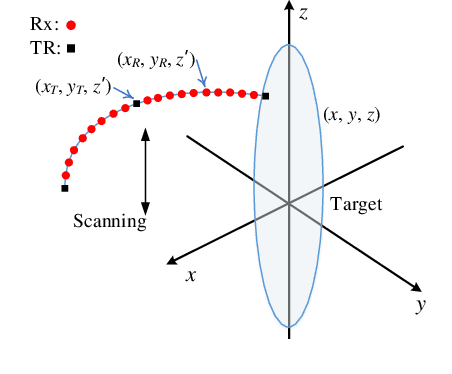
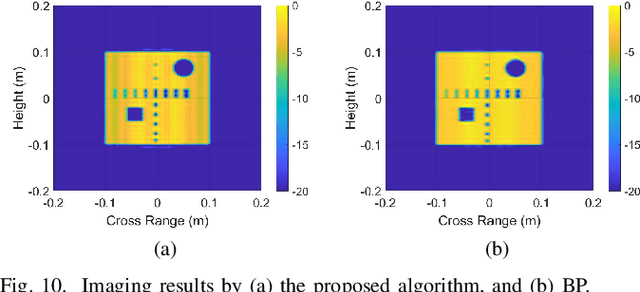
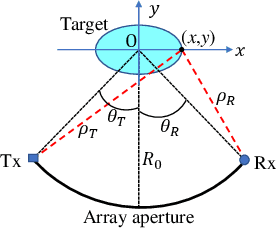
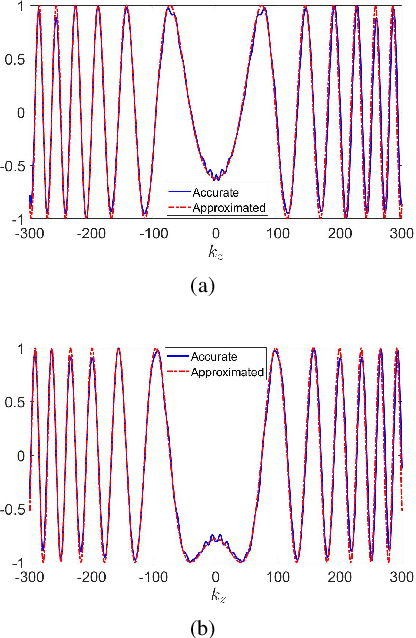
Abstract:Millimeter-wave (MMW) imaging has a wide prospect in application of concealed weapons detection. We propose a circular-arc multiple-input multiple-output (MIMO) array scheme with uniformly spaced transmit and receive antennas along the horizontal-arc direction, while scanning along the vertical direction. The antenna beams of the circular-arc MIMO array can provide more uniform coverage of the imaging scene than those of the linear or planar MIMO arrays. Further, a near-field three-dimensional (3-D) imaging algorithm, based on the spatial frequency domain processing, is presented with analysis of sampling criteria and resolutions. Numerical simulations, as well as comparisons with the back-projection (BP) algorithm, are provided to show the efficacy of the proposed approach.
 Add to Chrome
Add to Chrome Add to Firefox
Add to Firefox Add to Edge
Add to Edge